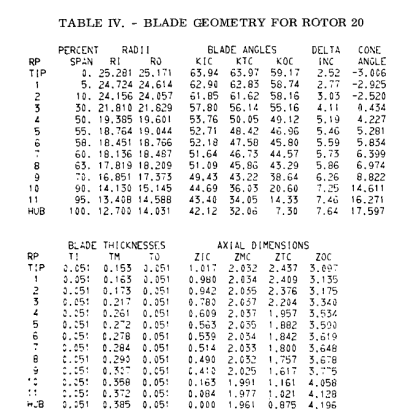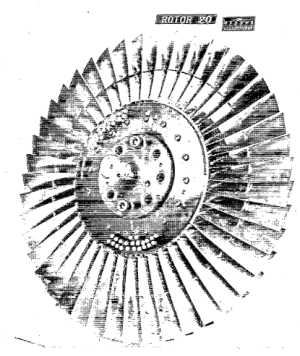Ceci est une ancienne révision du document !
Rotor 20
Original model
Rotor 20 is part of a research program to study the effect of tip velocity ratio on compressors performances. It has been designed for a stage tip velocity ratio of 0.8.
- Original technical report [1]:
@TechReport{moore1978design, author = {Moore, R. D. and Lewis, George W. and Osborn, Walter M.}, title = {Performance of a Transonic Fan Stage Designed for a Low Meridional Velocity Ratio}, institution = {NASA Lewis Research Center Cleveland, OH, United States}, note = {NASA-TP-1298, url~: \url{https://ntrs.nasa.gov/api/citations/19780025164/downloads/19780025164.pdf}, 1978}} - Picture :
Useful documents
- PDF of the NASA report : rotor20.pdf
- CSV file of the blade geometry : rotor20_original.csv
Geometry
The geometry of rotor 20 is described in the original NASA report by the following tables. The length are in centimeters and the angles in degrees.

Aerodynamic design
| unit | values | |
|---|---|---|
| pressure ratio | [-] | 1.57 |
| mass flow | [kg/s] | 29.5 |
| tip speed | [m/s] | 425 |
| tip solidity | [-] | 1.3 |
| aspect ratio | [-] | 2.5 |
| number of blades | [-] | 44 |
| rotative speed | [rad/s] | 1686 |
Material properties
The original material of the rotor 20 is not defined in the NASA report.
Considered properties: Ti-6Al-4V, generic titanium :
| unité | valeurs | |
|---|---|---|
| alloy | [-] | Ti-6Al-4V |
| Young's modulus | [GPa] | 108 |
| density | [kg/m3] | 4400 |
| Poisson's ratio | [-] | 0.34 |
| yield stress | [GPa] | 0.824 |
First three natural frequencies (with clamped root) for the mesh:
- (1B): 1441.5 rad/s / 229.4 Hz
- (2B): 5124.4 rad/s / 815.6 Hz
- (1T): 8165.6 rad/s / 1299.6 Hz
CAD
Modèle original
Le rotor 20 fait partie d'un programme de recherche visant à étudier l'effet du rapport de vitesse en tête sur les performances des compresseurs. Il a été conçu pour un rapport de vitesse en tête de 0,8.
- Rapport technique original [1]:
@TechReport{moore1978design, author = {Moore, R. D. and Lewis, George W. and Osborn, Walter M.}, title = {Performance of a Transonic Fan Stage Designed for a Low Meridional Velocity Ratio}, institution = {NASA Lewis Research Center Cleveland, OH, United States}, note = {NASA-TP-1298, url~: \url{https://ntrs.nasa.gov/api/citations/19780025164/downloads/19780025164.pdf}, 1978}} - Photographie :
Documents utiles
- PDF du rapport de la NASA : rotor20.pdf
- Fichier CSV de la géométrie : rotor20_original.csv
Géométrie
La géométrie du rotor 20 est décrite dans le rapport d'origine de la NASA par les tableaux suivants. Les grandeurs sont en centimètres et en degrés.
Caractéristiques aérodynamiques
| unités | valeurs | |
|---|---|---|
| taux de compression | [-] | 1,57 |
| débit massique | [kg/s] | 29,5 |
| vitesse en tête | [m/s] | 425 |
| solidité en tête | [-] | 1,3 |
| allongement | [-] | 2,5 |
| nombre d'aubes | [-] | 44 |
| vitesse de rotation | [rad/s] | 1686 |
Propriétés matériau
Le matériau original du rotor 20 n'est pas défini dans le rapport de la NASA.
Propriétés considérées : alliage de titane Ti-6Al-4v :
| unité | valeurs | |
|---|---|---|
| alliage | [-] | Ti-6Al-4v |
| module d'Young | [GPa] | 108 |
| masse volumique | [kg/m3] | 4400 |
| coefficient de Poisson | [-] | 0,34 |
| limite élastique | [GPa] | 0,824 |
Fréquences des trois premiers modes (noeuds de la base encastrés) pour le maillage :
- (1B): 1441,5 rad/s / 229,4 Hz
- (2B): 5124,4 rad/s / 815,6 Hz
- (1T): 8165,6 rad/s / 1299,6 Hz

